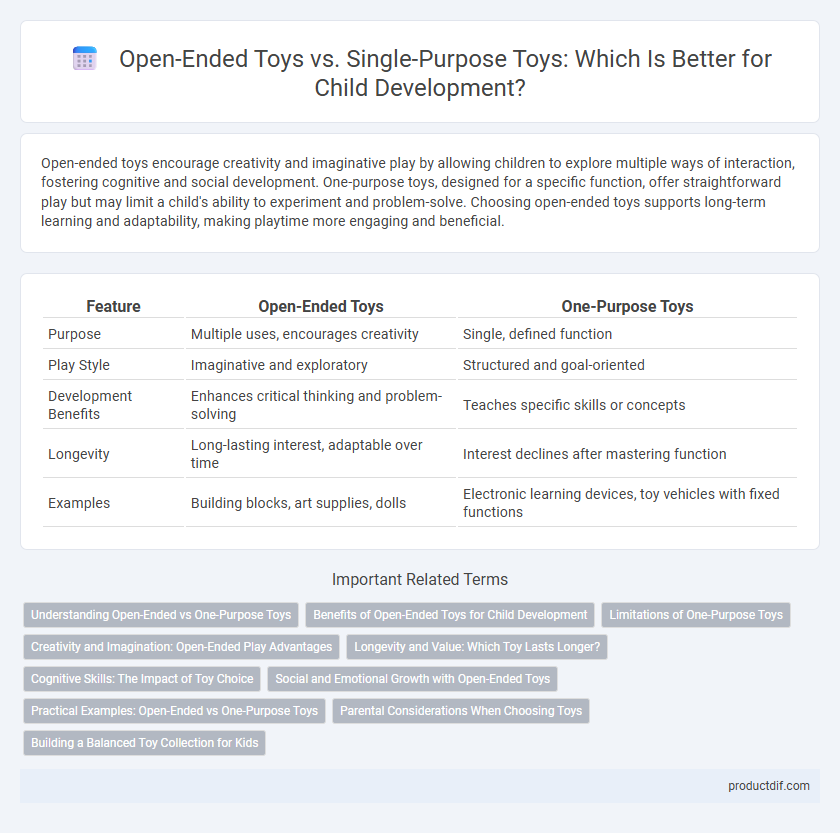Open-ended toys encourage creativity and imaginative play by allowing children to explore multiple ways of interaction, fostering cognitive and social development. One-purpose toys, designed for a specific function, offer straightforward play but may limit a child's ability to experiment and problem-solve. Choosing open-ended toys supports long-term learning and adaptability, making playtime more engaging and beneficial.
Table of Comparison
| Feature | Open-Ended Toys | One-Purpose Toys |
|---|---|---|
| Purpose | Multiple uses, encourages creativity | Single, defined function |
| Play Style | Imaginative and exploratory | Structured and goal-oriented |
| Development Benefits | Enhances critical thinking and problem-solving | Teaches specific skills or concepts |
| Longevity | Long-lasting interest, adaptable over time | Interest declines after mastering function |
| Examples | Building blocks, art supplies, dolls | Electronic learning devices, toy vehicles with fixed functions |
Understanding Open-Ended vs One-Purpose Toys
Open-ended toys encourage creativity, imagination, and problem-solving by allowing children to use them in multiple ways, such as building blocks or art supplies. One-purpose toys have a fixed function or outcome, designed to perform a specific activity like a puzzle or a toy car. Understanding the distinction helps caregivers choose toys that promote developmental skills and cognitive flexibility in children.
Benefits of Open-Ended Toys for Child Development
Open-ended toys foster creativity, problem-solving skills, and imagination by allowing children to explore multiple ways of play without restrictions. These toys enhance cognitive development and fine motor skills since children actively manipulate the components to create new scenarios or objects. Research shows that open-ended play supports emotional resilience and social interaction, promoting holistic child growth compared to one-purpose toys.
Limitations of One-Purpose Toys
One-purpose toys restrict creativity by offering limited play scenarios, reducing opportunities for imaginative exploration and problem-solving. These toys often lose interest quickly since their use is narrowly defined, leading to decreased engagement over time. In contrast, open-ended toys foster cognitive development by allowing multiple ways to play, adapting to a child's evolving skills and interests.
Creativity and Imagination: Open-Ended Play Advantages
Open-ended toys such as building blocks, art supplies, and dress-up costumes promote creativity and imagination by allowing children to invent their own scenarios and solutions without preset outcomes. These toys encourage cognitive development, problem-solving skills, and innovative thinking by offering limitless possibilities for play. In contrast, one-purpose toys, designed for a specific function, restrict imaginative play and often limit the child's creative engagement.
Longevity and Value: Which Toy Lasts Longer?
Open-ended toys offer greater longevity by encouraging creativity and multiple uses, often remaining engaging as children grow. One-purpose toys tend to have a shorter lifespan due to their limited functionality and quick loss of interest. Investing in open-ended toys provides better value over time, as they adapt to various developmental stages and imaginative play.
Cognitive Skills: The Impact of Toy Choice
Open-ended toys such as building blocks and art supplies significantly enhance cognitive skills by encouraging creativity, problem-solving, and critical thinking. One-purpose toys often limit cognitive development by guiding children toward specific outcomes with less room for imagination. Choosing open-ended toys fosters adaptable thinking and innovation, essential for effective learning and intellectual growth.
Social and Emotional Growth with Open-Ended Toys
Open-ended toys, such as building blocks and art supplies, foster social and emotional growth by encouraging collaboration, communication, and imaginative play among children. These toys promote problem-solving skills, empathy development, and self-expression, helping kids build stronger interpersonal relationships and emotional resilience. In contrast, one-purpose toys often limit these opportunities, as their predefined functions restrict creativity and social interaction.
Practical Examples: Open-Ended vs One-Purpose Toys
Open-ended toys such as building blocks and modeling clay encourage creativity and imaginative play by allowing children to explore multiple ways of use. One-purpose toys like puzzles and remote-controlled cars offer specific functions that target particular skills but limit imaginative potential. Practical examples show that open-ended toys support cognitive and social development more effectively than one-purpose toys by fostering problem-solving and versatile play scenarios.
Parental Considerations When Choosing Toys
Parents prioritize open-ended toys for their ability to foster creativity, problem-solving skills, and prolonged engagement by allowing children to explore multiple ways to play. One-purpose toys, while often more straightforward and predictable, can limit imaginative development but may help in teaching specific skills or concepts. Careful consideration of a toy's versatility, educational value, and the child's developmental stage guides parents in making purposeful purchasing decisions.
Building a Balanced Toy Collection for Kids
Open-ended toys like building blocks and art supplies foster creativity, problem-solving, and imaginative play, offering children endless ways to explore and learn. One-purpose toys, such as puzzles or action figures, provide focused skill development and targeted entertainment, enhancing specific abilities like spatial reasoning or storytelling. A balanced toy collection combines both types, promoting holistic growth by encouraging flexibility, critical thinking, and specialized skills essential for childhood development.
Open-ended toys vs one-purpose toys Infographic

 productdif.com
productdif.com